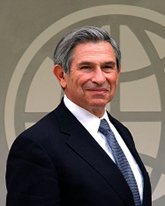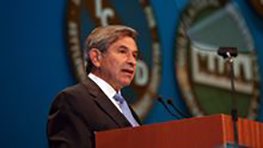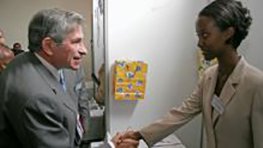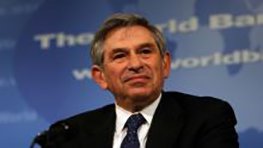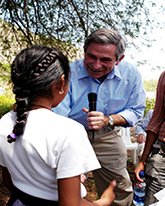10th President of the World Bank Group, June 1, 2005 - June 30, 2007
Paul D. Wolfowitz, the World Bank’s 10th president, served from June 1, 2005, to June 30, 2007. During his tenure he placed emphasis on support for Africa, encouraged clean energy initiatives, and strengthened governance and anti-corruption policies at the Bank, including creating a Stolen Assets Recovery Initiative to help developing countries regain looted assets.
Personal History
Paul Dundes Wolfowitz was born on December 22, 1943, in Brooklyn, New York. He attended Cornell University, earning a degree in mathematics and chemistry in 1965, and in 1972 he received a Ph.D. in political science from the University of Chicago with a dissertation on nuclear proliferation in the Middle East.
Prior to his arrival at the Bank Wolfowitz held a number of increasingly important positions in the U.S. government, including State Department Director of Policy Planning (1981-1982), Assistant Secretary of State for East Asian and Pacific Affairs (1982-1986), Ambassador to Indonesia (1986-1989), Under Secretary of Defense for Policy (1989-1993) and Deputy Secretary of Defense (2001-2005). Between 1994 and 2001 he was Dean of the School of Advanced International Studies at Johns Hopkins University.
Wolfowitz married Clare Selgin in 1968; they had three children. The couple divorced in 2002.
The Setting
The external setting for the Bank was particularly important for Paul Wolfowitz’s tenure. The war in Iraq was dragging on, and as a former senior Defense Department official Wolfowitz was identified with the pursuit of the conflict. In Lebanon, former prime minister Rafik Hariri was assassinated in February 2005 and the “Cedar Revolution” forced the Syrian army to depart after 29 years of occupation. North Korea announced it possessed nuclear weapons. One positive event was the entry into force of the Kyoto Protocol, the international treaty that commits parties to reduce greenhouse gas emissions and thereby fight global warming. A little noticed but ultimately major change also occurred in the spring of 2005: YouTube posted its first video, launching the revolutionary worldwide sharing of video images (in 2006 the Bank began posting to YouTube).
Accent on Africa
Although 2006 was a record year for IDA lending, especially in Africa, by April 2007 the Bank decided to revise its ambitious goals. Although it found substantial achievements during the eighteen months of the Plan, among them having provided 1.7 million people with access to safe water and reaching 173 million people with HIV prevention messages, and noting that African economic growth was strong, it decided the original plan as “too wide ranging.” The Plan refocused on eight areas:
- Strengthen the African private sector;
- Increase the economic empowerment of women;
- Build skills for competitiveness in the global economy;
- Raise agricultural productivity;
- Improve access to and reliability of clean energy;
- Expand and upgrade road networks and transit corridors;
- Increase access to safe water and sanitation; and
- Strengthen national health systems and combat malaria and HIV/AIDS.
By 2008, the Bank’s Internal Evaluation Group (IEG, formerly Operations Evaluation Department) reported that in Africa the share of projects with moderately satisfactory or better outcomes “improved the most of any Region over fiscal 2003-07” but still “lags behind other regions.” It noted that Africa has “difficult operating conditions” but argued that the Bank “has to find ways to deliver outcomes in adversity, as a central part of its mission” and highlighted a successful Bank investment in northern Ethiopia. And the EG applauded the Africa Region’s development of “the Africa Results Monitoring System as a comprehensive online system in the Bank for monitoring on-the-ground results of Bank activities.”
Debt relief
At its meeting in June 2005, the G-8 agreed to write off the entire US$40 billion debt owed by 18 Highly Indebted Poor Countries (HIPC) to the World Bank, the International Monetary Fund and the African Development Fund. The G-8 decided that 20 more countries, with an additional US$15 billion in debt, would be eligible for debt relief if they met targets on fighting corruption and continued to fulfill structural adjustment conditionalities to eliminate impediments to private investment. Known as the Multilateral Debt Relief Initiative (MDRI), it was designed to help accelerate progress toward the Millennium Development Goals. Almost two-thirds of the total would be borne by IDA.
To support the MDRI, the Bank through IDA took steps to help countries preserve the benefits of debt relief, increase their poverty-reducing expenditures, and manage their debt profile and associated financial risks. These steps included:
- A joint Bank-Fund Low-Income Countries Debt Sustainability Framework;
- A grant allocation system to mitigate debt distress risks detected in Debt Sustainability Analyses;
- A Non-Concessional Borrowing Policy; and
- Creation of the Debt Management Facility, a grant facility financed by a multi-donor trust fund, to help strengthen debt management capacity and institutions in developing countries.
By June 2009, the Bank concluded that the MDRI strategy had been successful. Thirty-five countries had been given HIPC assistance, and by the end of 2008 the debts of those countries were reduced by over 80 percent. Moreover, poverty-reduction spending in those countries had increased by about 2 percent of GDP between 2001 and 2008 while debt service decreased by the same amount. Still, as the Bank’s IEG warned in 2006, “Debt reduction is not sufficient for debt sustainability” and the Bank would need to be clear about the importance of policy actions by governments and other partners to sustain repayment capacities.
Governance and anti-corruption
In February 2006 the African Development Bank Group, the Asian Development Bank, the European Bank for Reconstruction and Development, the European Investment Bank Group, the Inter-American Development Bank Group, the International Monetary Fund and the World Bank Group established a joint task force to develop a framework for preventing and combating fraud and corruption in the activities and operations of their institutions. The result, issued in September 2006, was a statement of principles for the internal work of the organizations and a pledge to work with countries and other stakeholders to strengthen governance and combat corruption.
To develop the strategy, the Bank “undertook an unprecedented round of international consultations to explore the views of stake holders” on how the Bank’s work on governance and anticorruption could be strengthened to reduce poverty. The result was a set of seven “guiding principles,” the first of which was, “The World Bank Group’s focus on governance and anticorruption (GAC) follows from its mandate to reduce poverty—a capable and accountable state creates opportunities for poor people, provides better services, and improves development outcomes.” The strategy was endorsed by the Board of Executive Directors in March 2007, but its implementation would be left to the Bank’s next president.
A further step was the partnership with the United Nations Office on Drugs and Crime to help developing countries recover assets stolen by corrupt leaders. The Stolen Asset Recovery Initiative (StAR) was, said Wolfowitz, “a moral obligation. Recovering even a portion of the stolen assets will help fund development and social programs, or badly-needed infrastructure.”
Clean Energy Investment Framework
In the wake of the G-8’s September 2005 “Plan of Action on Climate Change, Clean Energy and Sustainable Development,” the Development Committee asked the Bank to develop an investment framework for clean energy and development. The Bank presented the outlines of the framework at the 2006 Spring Meetings of the Development Committee and reported further progress at the 2006 Annual Meetings. These papers made the case for improving access to energy in developing countries, particularly in Sub-Saharan Africa; reducing greenhouse gas emissions and speeding the transition to a low carbon economy; and helping developing countries adapt to climate risks. The Development Committee broadly endorsed the key findings of the report, and a final action plan was agreed to by the Board of Executive Directors in March 2007.
IFC and private sector development
In his key first address to the Bank and Fund Annual Meeting, Wolfowitz said that sustainable development depended “as much on leadership and accountability, on civil society and women, on the private sector and on the rule of law, as it does on labor or capital.” He added, “A vibrant private sector is the most important engine of growth and job creation.”
Wolfowitz was attentive to the work of the International Finance Corporation (IFC), the arm of the Bank focused on the private sector. During FY2007 IFC committed $8.2 billion for private sector development in developing countries, an all-time high (topping the FY2006 total by $1.5 billion), with $3 billion of the total going to IDA countries. Doing Business, an annual World Bank-IFC publication launched in 2004 at the end of the Wolfensohn years that reports on the burden of selected business regulations in countries, came to be known as one of the Bank Group’s flagship knowledge products during Wolfowitz’s presidency. In his statement announcing his departure from the Bank, Wolfowitz said, “Perhaps most of all, I am proud of the innovative work the IFC is doing, through the ‘Doing Business’ report, to help developing countries identify the obstacles to private sector growth and I have been delighted at how eager many government s have been to remove those obstacles once we help identify them.”
Internal organization
In 2005 Wolfowitz introduced several organizational changes. Two large units were merged to create the Sustainable Development Network and the oversight of the implementation of “safeguards” in the Bank projects (that is, policies to prevent and mitigate undue harm to people and their environment in the development process) was moved to a reorganized vice-presidency for Operations Policy and Country Services.
The Bank’s Department of Institutional Integrity (INT) had been created in 2001 to investigate allegations of fraud or corruption or misconduct either by Bank staff or in Bank-financed projects. When the first head of the Department completed his five-year term and departed in 2006, Wolfowitz selected as his replacement a Bank staff member who simultaneously served as a counselor to the Bank President, raising concerns among both Bank staff and outside observers. Wolfowitz increased the Department’s budget by 24% in 2006, but questions persisted about the functioning of the Department and the tensions in operating relationships inside the Bank. In February 2007 Wolfowitz and the Board of Executive Directors announced that an “independent panel of experts” would be constituted to “assess how INT can best contribute to the Bank Group’s mission.” Headed by former U.S. Federal Reserve chairman Paul Volcker, the panel’s report would be submitted to the next President.
Departure
In the spring of 2007 a controversy arose over the treatment afforded to a staff member closely associated with the president. Wolfowitz then resigned.
